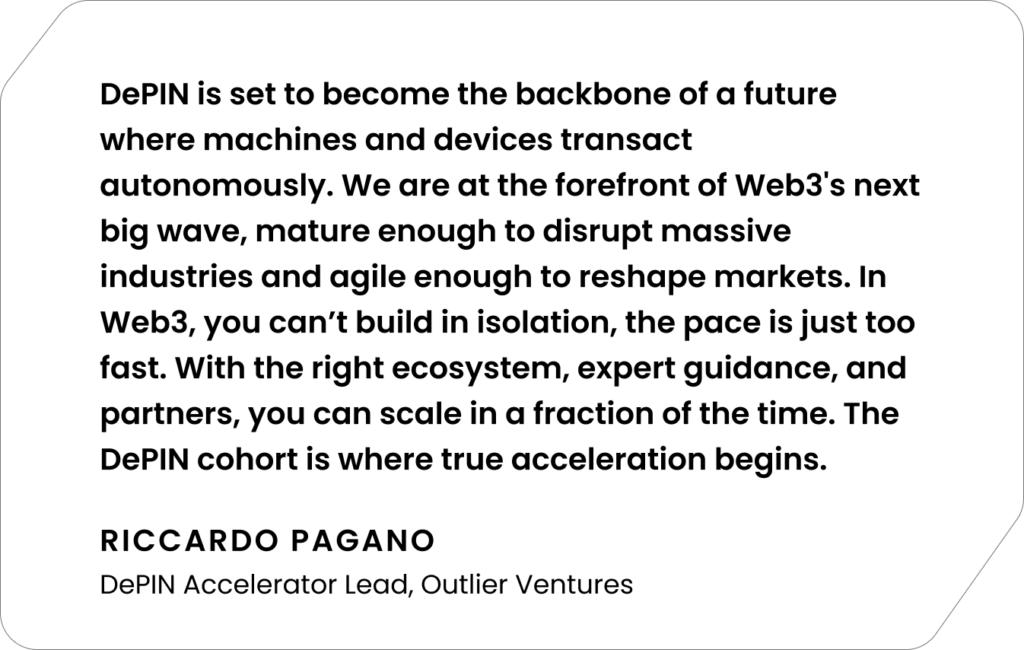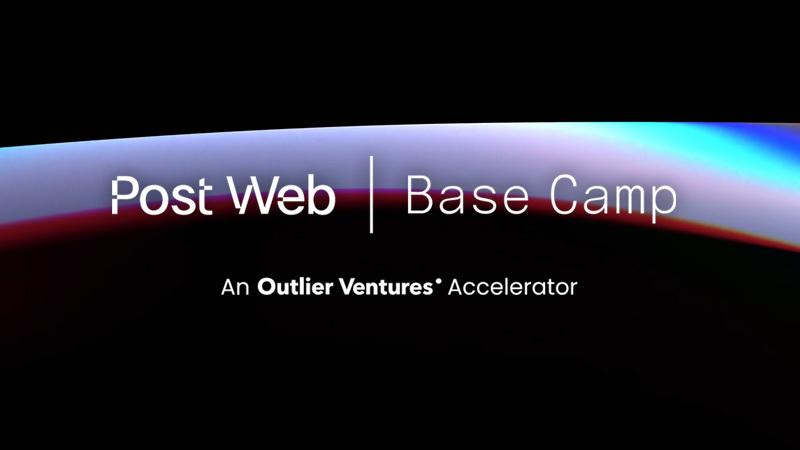Welcome back to our blog series for founders building at the frontier of AI and Web3. In this edition, we explore how DePIN is becoming the foundational layer for the machine-driven internet, and how our accelerator helps early teams turn infrastructure into product.
Authors: Jasper De Maere | X | LinkedIn | Greysen Cacciatore | X | LinkedIn
Autonomous agents are emerging as users of the internet. And like any user, they need reliable infrastructure to interact with the world: compute, storage, data feeds, and sensors. Only this time, it can’t be centralized.
Decentralized Physical Infrastructure Networks (DePIN) provide the trustless, composable backend for this new reality. We define DePIN projects as those that (i) use blockchain to coordinate and maintain decentralized infrastructure and (ii) rely on or impact physical nodes such as servers, sensors, or other edge devices.
DePIN networks use blockchain and tokens to coordinate real-world infrastructure, giving agents the ability to observe, act, and transact across digital and physical space. As agents become the primary actors in The Post Web, DePIN is how they plug into the real world. (To dive a little deeper, read: DePIN And The Platform Economy)

Why Now?
Founders don’t have time for hype. Here’s why DePIN is real…and urgent.
- Compute is cheap – Reduced compute and hardware costs make it viable to spin up distributed infrastructure at the edge.
Exhibit 5: Below the historical cost ($/TB) of computer memory and storage since 2000. Hardware cost curves continue to come down, democratizing heavy duty computing.

- Removing Single Point Of Failure & Control – As AI systems become more economically vital, the centralized infrastructure they rely on introduces a growing risk of failure and control. This concentration of power is starting to get scrutinized, and DePIN offers a resilient, decentralized alternative to mitigate these vulnerabilities.
Exhibit 6: Gen AI market share across (1) GPU, (2) Foundation models & platforms & (3) Gen AI services. Key centralization risk mainly lies in (2) Foundation models & model management platforms

- Overcoming the “Data Wall” – As AI’s hunger for real-time, high-quality data grows, a new bottleneck is emerging. DePIN networks offer a breakthrough by using tokens to incentivize the capture of structured data at the edge, especially in hard-to-reach but high-value locations.
Exhibit 7: Projection of stock of public text and data usage. By 2028, the data wall will become a major bottleneck as AI exhausts readily available human-generated data and demand for real-time, high-quality inputs outpaces what traditional, centralized sources can supply.

- Agent-Driven Demand – AI agents require persistent, low-latency infrastructure to observe, act, and transact. DePIN provides it.
DePIN: The Infra Layer Agents Actually Need
As we move into The Post Web, infrastructure must adapt to a world where AI agents autonomously fulfill user intent and interact with decentralized systems. DePIN is emerging as the foundational substrate to support this shift, coordinating compute, storage, connectivity, and real-world data through decentralized networks. While DePIN’s first wave focused on digital infrastructure, we are now entering a second wave driven by the needs of agents: context-rich environments, real-time sensing, edge compute, and resilient, privacy-respecting networks.
This shift is being accelerated by several converging forces. The cost of hardware and compute has dropped significantly, making it possible for individuals and communities to contribute meaningful infrastructure without massive upfront investment. At the same time, AI-powered interfaces and agents are simplifying how users engage with these networks, removing technical barriers and unlocking new forms of participation. As AI adoption grows, so do concerns about privacy and control over data, creating a natural pull toward decentralized, user-owned infrastructure. The growing demand for real-time, context-aware data is also pushing DePIN into new domains, turning physical environments into data-rich systems that agents can directly observe and act upon. Underpinning all of this is a maturing utility token landscape, providing more robust and sustainable ways to coordinate supply and demand across these networks.
DePIN is no longer just a Web3 infrastructure trend, it is a critical building block for the Post Web’s agentic economy.
Key Trends Driving DePIN Forward
DePIN is already showing strong market signals. Founders are both experimenting with new infrastructure coordination and building real businesses around them.
Here are three trends that show why DePIN is moving from fringe to foundational, and why the next wave of agents will rely on it.
Revenue Growth
Several DePIN projects have grown annual recurring revenues into the millions, showing strong business prospects for DePIN projects.
Exhibit 8: DePIN Revenue breakdown from 2022 to 2024 by segments (i.e. offchain, onchain, and AI). DePIN revenues saw x32.3 increase from 2023 to 2024.

AI Integration
Integration with artificial intelligence technologies is enhancing the overall functionality and efficiency of DePIN networks and operations.
Exhibit 9: Below breaks down DePIN revenues in 2024 by segment including offchain (14.2% of total), onchain (8.3% of total), and AI (70% of total).

Competitive Price Points
DePIN is becoming increasingly price competitive, often offering compute, storage, and data services at lower cost than traditional hyperscalers and centralized providers, without sacrificing performance or flexibility.
What Founders Should Build
If you’re building the next generation of intelligent, autonomous systems, DePIN isn’t a nice-to-have…it’s the coordination layer.
Here’s where we see the biggest design space emerging:
Next-Gen Compute Networks
Projects building next-gen compute networks bridging AI’s soaring inference demands with on demand processing power.
As LLMs and agents grow more resource-intensive, the traditional cloud providers alone can’t meet the rising demand for cost-effective, scalable compute. This opens the door for decentralized compute networks that tap into idle GPU capacity and offer pay-as-you-go services, all coordinated via smart contracts. However, interoperability standards, efficient job scheduling protocols, and robust reputation & incentive systems for node operators are still works in progress. Well-designed compute markets can fuel AI innovation while giving participants an economic stake in the ecosystem.
Data Curation Networks
Projects building decentralized data curation and labeling networks are leveraging token incentives to crowdsource high-quality datasets for AI development.
While AI models have become increasingly powerful, the quality and breadth of the data they’re trained on remains a bottleneck. Decentralized data curation and labeling networks aim to solve this by distributing the task of gathering, cleaning, and annotating data across a global community, all coordinated through tokenized incentives. This can accelerate the creation of specialized or underrepresented datasets while distributing ownership of that data among contributors. These networks complement existing data sources by enabling both horizontal and vertical data aggregation, unlocking broader coverage and deeper context.
However, these projects still face challenges around verifying data authenticity, preventing malicious inputs, and standardizing labeling practices. If done right, they could unlock large-scale, lower-cost, and higher-fidelity data pipelines.
Robotics
Projects building decentralized robotics networks that are supporting open, tokenized coordination among fleets of autonomous machines for tasks like delivery, logistics, & more.
A handful of DePIN projects are starting to tokenize robot operation and maintenance, rewarding participants who supply infrastructure for robotics. However, major challenges persist around data exchange, consensus mechanisms for robot decision-making, and liability frameworks in the event of malfunctions or accidents. If these are resolved, we could see a future where diverse, self-managing robot networks carry out specialized missions in a transparent, user-owned environment, reshaping the highly-anticipated robotics markets.
TL;DR for Founders
If you’re building agentic applications, your infrastructure strategy can’t stop at the cloud.
DePIN is the missing layer. It’s not niche, it’s the substrate:
- Infrastructure that moves at machine speed
- Marketplaces for real-world compute and data
- The coordination layer for agents in physical environments
In the Post Web, infrastructure is user experience, especially for autonomous agents. This unlocks a new product surface for founders:
- Need low-latency compute? Build it.
- Need real-time, high-context data? Incentivize it.
- Need agents to sense and act in the world? Coordinate the network.
The best teams in The Post Web will build both the applications for agents to utilize and the physical infrastructure to power them.
Ready to Start Building?
If you’re building at the edge of AI, Web3, and real-world systems, we want to hear from you.
Post Web Base Camp is our accelerator for founders shaping the agentic internet. We provide:
- Funding
- Hands-on technical support
- A global network of investors, ecosystem partners, and technical experts

Want to receive the rest of this blog series in your inbox? Subscribe to our newsletter and stay ahead of the curve.
The machines are coming online. Let’s build the rails they’ll run on.
The post DePIN: Infrastructure for a Machine-Driven Internet appeared first on Outlier Ventures.





